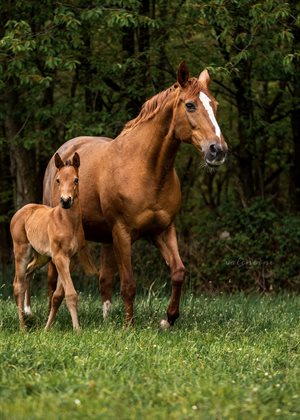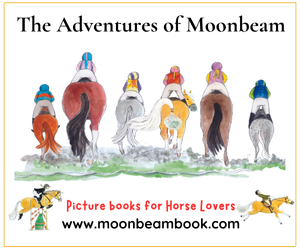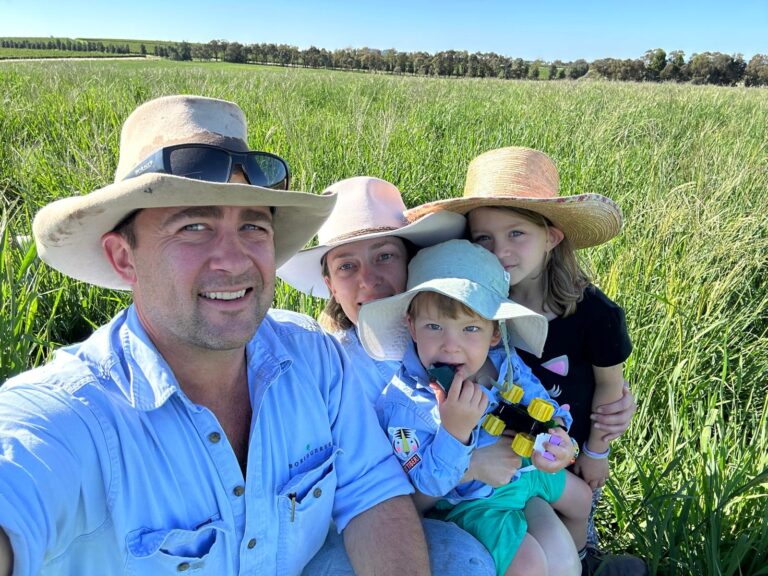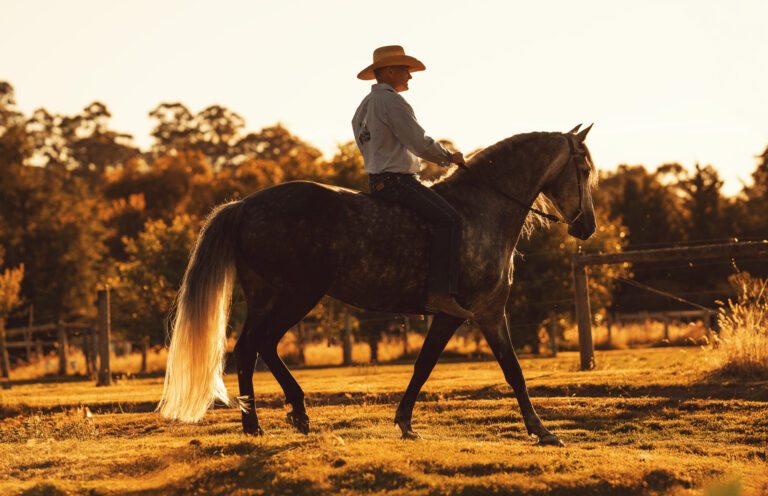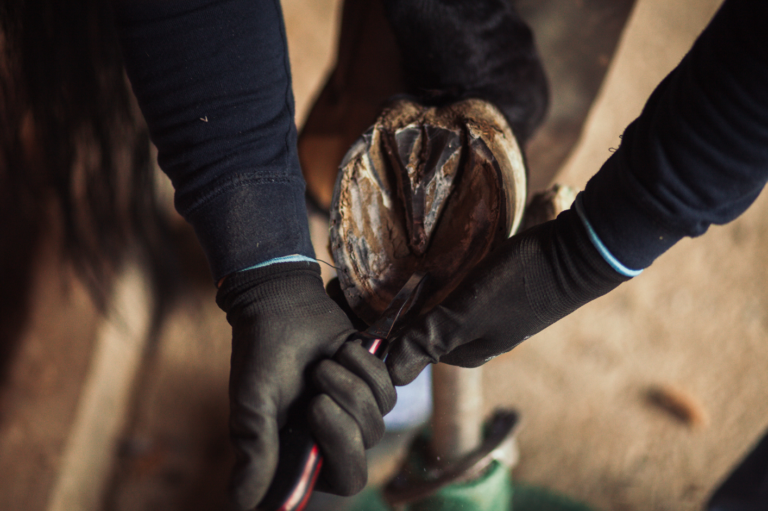This article has appeared previously with Equestrian Life. To see what’s in our latest digital issue, click here.
The equine breeding season is typically from spring through summer and into autumn.
Mare tactics
By Maxine Brain
Mares are generally referred to as “seasonally polyoestrous”, meaning they will cycle or ovulate multiple times during their breeding season. The equine breeding season is typically from spring through summer and into autumn, but a small percentage of mares will cycle throughout the whole year.
Mares usually cycle on a 21-day rotation, meaning they ovulate “once” every 21 days. I say “once” loosely as many mares will ovulate off more than one follicle in a given cycle, which is still considered to be the one cycle although it may lead to twins or on rare occasions triple pregnancies. Occasionally mares may have a shorter or longer cycle length, but the majority will maintain the same cycle length throughout the season. That is, if their cycle length is 20 days then they will ovulate every 20 days, not 22 days one time and 19 the next, unless they have had their cycle artificially manipulated or they have a health issue.
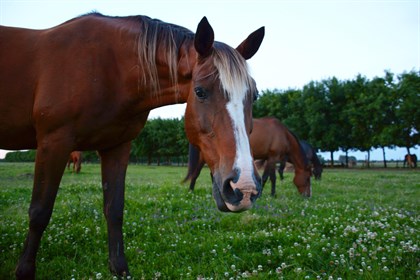
Mares are generally referred to as “seasonally polyoestrous”, meaning they will cycle or ovulate multiple times during their breeding season.
Cycles are broken into two phases, oestrus (in season) and dioestrus (not in season). The oestrous phase is where the dominant follicle(s) rapidly develops and grows before ovulating to release an egg into the reproductive tract. This part of the cycle can be variable in length from two to 12 days but is usually around the five to seven days. Usually at the start of the season mares will remain in oestrus for longer than during the height of the breeding season (summer) when they may only stay in oestrus for two to three days.
The triggering factor for mares to begin to cycle is the increasing period of daylight, detected by a gland in the brain and translated into a hormone that sets the process in motion. This increasing period of light correlates with the lengthening days seen after the winter solstice.
A period of 16 hours of daylight is what is naturally required to start the majority of mares cycling. This natural trigger factor is often manipulated by the use of artificial lighting to mimic the 16-hour day and bring mares into season earlier than they would have if left to cycle normally.
When artificial lighting was first used to stimulate mares to come in early, lights of a certain strength were left on continuously from nightfall to midway through the night, so effectively the horse would have 16 hours light and eight of darkness. This process was then modified so that the lights would come on in the middle of the night and deliver a short burst of light (1-2 hours) around 9.5 hours after sunset, and this would trigger cycling. As times have progressed, many other systems hav e been devised to confuse the brain into believing the days have lengthened.
Currently on the market there is a device (trade name Equilume) that allows a blue light to be delivered directly into one eye of the horse, thus negating the need to have large areas of stables or paddocks lit, making it more economical in situations where there are not big numbers of mares in the one paddock.
Once triggered, hormones are produced in a part of the brain (the pituitary gland) that are released and target the ovary to bring about the onset of oestrous. A complex pathway of interactions between hormones results in positive and negative feedbacks on different parts of the reproductive system that allow the body to continually cycle through the season until such time as the mare is pregnant, or enters into anoestrous at the end of the breeding season. As would be expected, it is the shortening hours of daylight that trigger the mare to stop cycling at the end of the season.
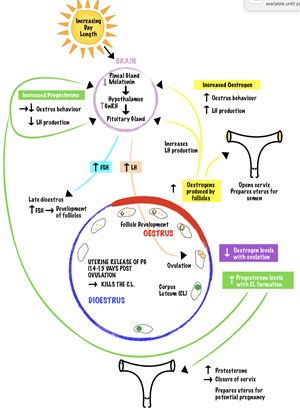
The reproductive cycle of a mare.
The key parts of the mare’s reproductive tract are not dissimilar to any other female mammal and include a uterus, two ovaries, a cervix, vagina and a vulva. As the mare cycles, a number of changes occur to her tract to ensure the body is ready to accept a stallion, become pregnant and maintain this pregnancy through to the delivery of a foal.
As the mare begins to cycle, estrogens are produced by the follicles on the ovaries, which feed back onto the uterus and cervix, causing the cervix to open and the uterus to become suitable for semen delivery and transportation up to the released egg. Estrogens also travel to the brain, producing behavioural changes, known to most as “horsing” (frequently squatting and urinating, winking). The change in behaviour allows the mares to readily accept the stallion as opposed to those mares that are not in season that would try and kick the stallion if he even remotely tried to cover her.
After ovulation, the resulting structure formed on the ovary is what is known as a “corpus luteum” (CL). This produces progesterone, which has the opposite effects on the body to what oestrogen does. Progesterone will close the cervix and prepare the uterus for implantation of a potential embryo. It will also give feedback to the brain and stop the oestrous behaviour, often making the mares much less erratic in their behaviour.
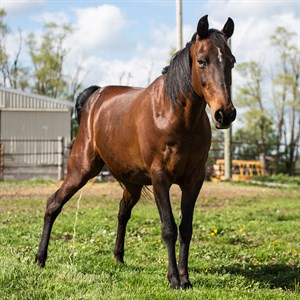
When mares are in season, they often exhibit behavioural changes, known to most as “horsing” (frequently squatting and urinating, and winking).
There are a number of key areas of the mare’s cycle that we can manipulate to help us to achieve the ultimate goal, which is getting the mare pregnant. Here are some medications commonly used in the reproductive barn.
PROSTAGLANDIN (PG): This is commonly used to bring a mare into season earlier than what her natural body cycle would do. It works by getting rid of the corpus luteum (CL) on the mare’s ovary (luteolysis). The CL produces hormones (progesterone) which feedback on the brain and prevent the release of hormones, which cause follicular growth (FSH). When the CL is prematurely terminated by PG, the negative feedback is removed and FSH is released, which brings the mare into oestrus. PG will not work in the early stages of CL life, as the CL must be at least five days old (five days post ovulation) to respond. As CLs are very important in the establishment and maintenance of early pregnancy, the use of PG can also be to cause abortion of an embryo before approximately 40 days, at which stage other structures in the mare’s reproductive tract have developed and take over the maintenance of pregnancy (endometrial cups).
CHORULON (HCG): This is used to help a mare ovulate faster than she would if left to naturally ovulate. It is used to time ovulation close to the point of service by the stallion or artificial insemination. A mare will not respond to chorulon unless the follicle is at a particular point in its development (usually bigger than 35mm) and the mare is in oestrus at the time. By that I mean some mares will be in dioestrus but have a large follicle present, which will not respond to this drug. This usually induces ovulation in 36 hours +/- 4 hours. The downside of using chorulon is that if it is used multiple times (3+) in the one season, there is an increased risk that the horse’s body will produce antibodies to the drug. These antibodies do not differentiate between the HCG in the chorulon and the horse’s natural luteinizing hormone (LH), meaning that the antibodies can attack the horse’s own LH and therefore delay the normal onset of ovulation (meaning mares may not ovulate properly at all). Fortunately, this phenomenon is only short-lived and it is safe to use chorulon the following season.
- DESLORELIN: This was commonly known as Ovuplant when it first emerged on the Australian market, however, now there are several companies that produce the active ingredient, which is deslorelin. This drug works similarly to chorulon except that its time to ovulation is 40 hours =/- 4 hours. As deslorelin is not closely related to any naturally occurring hormones in the body, the side effect of inducing antibodies to a body’s natural HCG does not occur.
- ALTRENOGEST: This drug is commonly used in female equine athletes as a method to keep mares and fillies out of oestrus. It is an artificial progesterone which helps mimic pregnancy, and is used in a number of situations for breeding, including to help mares transition from late anaestrous to oestrus (spring heating). Spring heating is where, at the start of the season, there are multiple small follicles all producing small amounts of estrogen, which combine to produce behaviour change in the mare (like they are in season), but none of the individual follicles are big enough to ovulate off and so the mare isn’t truly cycling. By giving the Altrenogest, the follicles are temporarily suppressed for a period (usually given for around 10 days) and when the treatment is stopped, the ovaries rebound and produce a follicle, or follicles, which are big enough to continue to develop and ovulate. Altrenogest is also used during pregnancy to help maintain pregnancies that may be compromised for various reasons such as infections (“placentitis”), high stress periods, and perceived times of low progesterone production.
There are two ways a mare can be mated: naturally or artificially. Natural mating can be done by preparing the mare to a point close to ovulating, and then hand serving her with the stallion. The other way of natural mating is for the mare to run with the stallion for a period of time, allowing the stallion to serve the mare when he chooses. Artificial breeding, as the name suggests, is the insemination of the semen into the mare using techniques other than the stallion’s penis. The semen used can be fresh, chilled or frozen.
Racing thoroughbreds are restricted to natural cover only, whereas the use of chilled and frozen semen is increasingly becoming the norm for many other breeds, especially standardbreds and warmbloods. Running mares with the stallion is a less popular method of cover due to the risk of injury to the stallion (and to the mare), but is often seen in small farm operations where the demand on the stallion is lower.
The different ways of breeding a mare and the pros and cons of each method is worthy of an article in itself, so I have only mentioned each type here and not gone into any detail.
READ THE LATEST NEWS ARTICLES HERE

